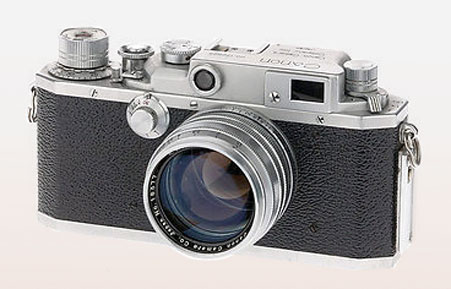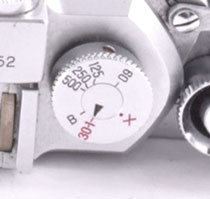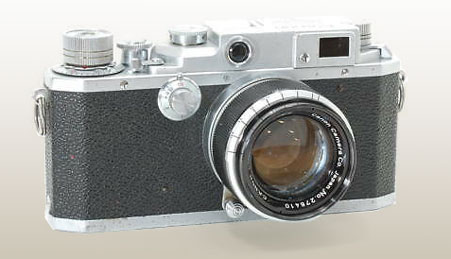Canon IIS2, IID2, IIF2 Rangefinder Cameras 1955-1956
A Description of three "improved" Canon models introduced in 1955

Canon IIS2 rangefinder camera of 1955 with flash rail on camera side
1954 Canon new camera introductions
Canon in late 1954 and early 1955 introduced a series of cameras with its newly designed shutter, and improvements to viewfinders which are today considered by collectors as perhaps the finest of the bottom-loading M39 rangefinder cameras. You can read about the Canon IVSB2 on another page of this canonrangefinder site, first having all the features described below. The Canon IVSB2, manufactured in 16,800 units over two years, remains one of the most respected 'user' cameras of the M39 screw-mount rangefinder series. The other 1954 improved introductions were the Canon IIS2, IID2 and IIF2, described below.
New 1954 Shutter Mechanism
The Canon shutter mechanism introduced in late 1954 retained the split high-speed dial on the camera top and slow speed dial on the camera front. Now, the split between dials was a 1/30 second, and X flash synchronization was added to the fast dial with a red X between 30 and 60, giving a speed of about 1/45 second. This was a higher flash synchronization speed - previous synchronized Canons had a synchronization shutter speed of 1/15 second. With this new shutter, the synchronization being increased to 1/45 second reduced the possibility of 'ghosts' during exposure. This had previously occurred when a 'ghost' image was captured from available light with a slow shutter speed after the flash image had been captured.
The new shutter also retained an X on the slow speed dial between 15 and 30 for synchonization with some strobe lights. Early electronic strobe lights sometimes had a delay in firing and this slower exposure time (about 1/20 second) allowed for such electronic strobes to be synchronized. The slow speed dial now had a lock to secure the dial while fast shutter speeds were being used.

In the center of the fast speed dial, illustrated above, is an independently rotating shaft which points to the selected speed. This allowed the fast speed to be selected either with the shutter cocked or not cocked (wound). The fast speed dial collar was lifted and rotated to the desired setting and then re-seated.
You will also see on the fast shutter speed photograph above that the Canon IIS2 did not have the highest 1/1000 shutter speed. This seems to have been a marketing decision, since the shutter was the same as that of the Canon IVSB2, which did include 1/1000. The Canon IIS2 was given a somewhat lower price of 68,000 yen (with a 50mm f/1.8 lens) compared with 74,500 yen for a Canon IVSB2 with the same lens. 4
Canon IID2 of 1955

The Canon IID2 was introduced in March 1955, one month after the Canon IIS2. It is simply the Canon IIS2 without synchronization, as can be seen in the photograph below. It was said to be difficult beginning in the mid-1950s to sell a 35mm camera without flash synchronization, but the IID2 sold 16,175 units 1955-1956, while the IIS2 sold about the same during the same period: 16,575 units. 1 Price probably helped. The Canon IID2 was priced at 58,000 yen, compared with the Canon IIS2 at 68,000 yen, and the Canon IVSB2 at 74,500 yen, all with the same 50mm f1.8 lens.

Canon IID2 top
The Canon IID2 seems to have been sold primarily in the domestic Japanese market and not in the PX stores (which still existed in Tokyo in 1955), nor in the export market where flash synchronization seems to have been required for stores to agree to stock the camera.
The Canon IIF2"

Canon IIF2 of 1955 with <E•P> mark
The Canon IIF2 is a somewhat unusual variation, since it is identical to the Canon IIS2, except it is synchronized for flash bulbs only and not for electronic strobe flash. 1 For this reason, the IIF2 lacks an X position on its slow speed dial. It did retain the slow speed dial lock.

Canon IIF2 slow speed dial
The IIF2 was only produced for 5 to 6 months in 1955, and sold only 2,625 units. Peter Dechert thought this low production was due to the continued popularity of the Canon IIF (which he calls the "PX camera") which continued to sell well in the Post Exchange stores. The Canon Canon IIF2 was priced identically with the Canon IID2 at 58,000 yen with the 50mm f1.8 lens.

Canon IIF2 top with the red <E•P> Post Exchange symbol
The Canon IIF2 would not be a "user" camera today, in spite of its robust construction, the new shutter mechanism and good viewfinder. Its small production makes it hard to find, either inside or outside of Japan. For this reason, collectors have bid up the price for this model on the secondary market to remarkable levels. Still, an interesting model in the changing engineering and marketing of Canon in the mid-1950s.
You can click on the links in the table below to consult other pages of the canonrangfinder.org site.
| Navigation: Click Below to Jump to Desired Subject Page | ||
|---|---|---|
| Canon Rangefinder Cameras - 1 | Canon Rangefinder Cameras - 2 | Canon Rangefinder Lenses |
| Canon S | Canon IVSB2 | Canon 19mm |
| Canon J | Canon IIS2, IID2, IIF2 | Canon 25mm |
| Canon NS | Canon VT, Canon L2 | Canon 28mm |
| Canon JS | Canon L1, L3 | Canon 35mm |
| Canon J-II | Canon VT Deluxe | Nikkor 50mm |
| Canon S-II | Canon VL, VL2 | Canon 50mm |
| Canon IIB | Canon VI-L, VI-T | Canon 85mm |
| Canon III, IIC, IV | Canon P | Canon 100mm |
| Canon IIIA, IVF, IVS | Canon 7 | Canon 135mm |
| Canon IIA, IID, IID1 | Canon 7s | Canon 200mm-1000mm |
| Canon IVSB | Minolta Rangefinders | Minolta Lenses |
| Canon IIF, IIS | Other Rangefinders | other M39 lenses |
| Go to canonrangefinder.com home page | ||
Any additions or corrections to these pages would be welcome simply by contacting this site as shown at the foot of this page .
Footnotes:
1 Dechert, Peter. Canon Rangefinder Cameras 1933-1968. Hove Collectors Books. West Sussex, United Kingdom. 1985. ISBN 0-906447-30-5.
Peter Dechert's book is the most important expert source of information regarding Canon Rangefinder Cameras.
2 Kitchingman, Peter. Canon M39 Rangefinder Lenses 1939-1971. A Collector's Guide. Published by Peter Kitchingman. Perth, Australia. 2008. ISBN 978-0-646-48144-9.
Peter Kitchingman's book is the definitive study of the more than three decades of M39 format camera lenses developed for Canon Rangefinder Cameras.
3 Nostalgic Canon Camera Book. 懐かしいキヤノン EI Publishing Co. Ltd. Tokyo, Japan. June 2003.
Peter Kitchingman's book is the definitive study of the more than three decades of M39 format camera lenses developed for Canon Rangefinder Cameras.
4 "Canon Camera Museum" history website. https://global.canon/en/c-museum/history/ published by Canon, Inc. accessed in 2019.
5 Rajner, Hans P. (author), John Wade (editor). Leica Copies. Classic Collections Publications. London, UK. ISBN 13: 9781874485056
Hans P. Rajner's book is an excellently detailed and carefully researched study of camera from around the world which used the Leica M39 lens mount and the same lens to film plane distance.
7 Dechert, Peter. Canon Single Lens Reflex Cameras 1959-1991. Historical Camera Publications. Yakima, Washington. 1992. ISBN 1-879561-04-2.
8 Tomlinson, Shawn M. The Film Photography Book. Lulu Pulbications. 2016. ISBN: 9781365263972
9 Sartorius., Ghester. Identifying Leica Lenses. Classic Camera 19. Tokyo, Japan. 2001. ISBN 4-257-12029-0
10 website http://www.nicovandijk.net/rflensmatrix.htm consulted 2019.
11 O'Reagan, Douglas M. Allied Exploitation of German Science after World War II. Johns Hopkins University Press. Baltimore, Maryland. 2019. ISBN 9781421428888
12 website www.canonrangefinder.servehttp.com consulted 2008.
13 Minolta expert Andrea Aprà has posted information on minoltarangefinders group and other groups and further detailed information by email. (thanks Andrea !)
14 website http://www.collection-appareils.fr/objectifs/ consulted 2019.
15 Small, Marc James. Non-Leitz Leica Thread-Mount Lenses. Wittig Books. Hückelhoven, Germany. 1997. ISBN 3-930359-47-2.
16 the Nikon Corporation website: https://imaging.nikon.com/history/ consulted 2019.
17 p 152. Ray, Sidney F. Photographic Lens ISBN 9780240510323
18 website http://www.rokkorfiles.com/Lens%20History.html accessed 2019
If you have any comments or questions about this Canon Rangefinder site, please e-mail me (Larry Huffman) at e-mail address: [email protected]